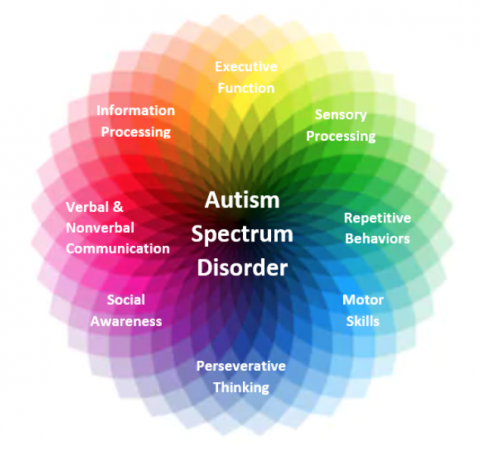The Impact of Very Early Intervention on Kids with Autism: What Moms And Dads Need to Know
The Impact of Very Early Intervention on Kids with Autism: What Moms And Dads Need to Know
Blog Article
Checking Out Autism: Approaches for Efficient Communication and Communication
Reliable interaction and interaction with individuals on the autism range necessitate a detailed understanding of their special demands and choices. Approaches such as employing clear language, utilizing visual supports, and fostering consistent routines can substantially improve involvement and minimize anxiousness. Recognizing the relevance of non-verbal signs and shared interests leads the method for significant connections. The intricacies of these approaches disclose additional considerations that merit expedition, especially in exactly how they can be adapted to specific experiences and diverse contexts. What might these adjustments appear like in practice?
Recognizing Autism Spectrum Condition
Autism Range Condition (ASD) encompasses a range of neurodevelopmental problems characterized by difficulties in social communication, communication, and repetitive habits. The term "range" reflects the diverse indications and varying levels of seriousness experienced by people with ASD. While some may display substantial impairments, others may present high-functioning attributes, permitting higher self-reliance in life.
The start of ASD normally occurs in early youth, with indicators often identifiable by age 2. Very early indicators may consist of postponed speech growth, limited eye contact, and problems in comprehending social signs. The specific etiology of ASD remains unclear, research study suggests a combination of ecological and hereditary variables plays a critical function in its advancement.
As an outcome, interventions and support customized to private demands are vital for cultivating interaction and social abilities. Recognizing the intricacy of ASD is important for promoting awareness, acceptance, and efficient techniques that promote purposeful communications with individuals on the range.

Significance of Clear Interaction
Effective communication is essential for fostering understanding and link, especially for individuals with Autism Spectrum Condition (ASD) Clear communication not just helps with social communications however likewise boosts the person's capability to reveal their needs, emotions, and ideas. For people with ASD, the nuances of language can frequently be challenging; consequently, using unambiguous and uncomplicated language is important.
Moreover, clear interaction helps in reducing irritation and anxiety that might develop from misconceptions. When messages are conveyed in a straight and consistent way, people with ASD are much better equipped to analyze information properly, which can dramatically boost their social involvement and engagement in numerous setups.
Developing routines and utilizing aesthetic supports can better bolster clear interaction. These strategies supply people with foreseeable structures that assist understanding and retention of information. In addition, actively being and listening patient throughout interactions promotes an encouraging environment where people with ASD really feel valued and understood.
Inevitably, focusing on clear communication not only empowers individuals with ASD however also promotes even more purposeful connections with their peers, caretakers, and the broader community, leading the way for joint connections and comprehensive interactions. - autism
Non-Verbal Interaction Methods
Interaction expands past words, and for individuals with Autism Range Disorder (ASD), non-verbal hints play a significant duty in communications. Non-verbal communication methods can include facial expressions, motions, body language, and eye call, all of which function as important parts for conveying intentions and emotions.
Recognizing and analyzing these non-verbal signals can improve communications with individuals with ASD. A warm smile or open stance can produce a welcoming environment, motivating engagement. Likewise, utilizing visual help-- such as picture cards or icons-- can connect communication spaces and aid share messages a lot more properly.
It is recommended you read likewise important to be conscious of individual room, as individuals with ASD might have various comfort degrees concerning proximity. Observing their reactions to physical closeness can educate appropriate adjustments.

Creating Helpful Environments
Producing a helpful atmosphere is critical for cultivating favorable interactions and boosting the wellness of people with Autism Range Disorder (ASD) Such environments can considerably decrease stress and anxiety and develop a feeling of safety, allowing people to reveal themselves more easily.
To accomplish this, it is vital to take into consideration sensory level of sensitivities that people with ASD may experience. Changing the physical area to include their explanation soft illumination, minimal background sound, and comfy seats can create a calming environment. Furthermore, utilizing constant regimens and clear visual timetables can aid individuals expect shifts and lower unpredictability, additional advertising comfort.
Social rooms should be structured to minimize overwhelming stimuli while providing chances for involvement in recommended activities. Facilitating areas marked for peaceful time can also work as a sanctuary throughout minutes of anxiety. Significantly, including components of selection encourages individuals, permitting them to work out company in their setting.

Motivating Social Interactions
Cultivating social interactions amongst people with Autism Range Disorder (ASD) calls for deliberate strategies that prioritize comfort and involvement. Developing foreseeable routines can aid minimize anxiousness, making social settings more approachable. Developing structured settings with specified duties and functions enables individuals to engage without the overwhelming pressure of disorganized social dynamics.
Incorporating passions and strengths into social tasks can function as a catalyst for communication. As an example, arranging group activities around shared leisure activities or subjects of fascination can help with natural conversations and connections. In addition, making use of visual supports, such as photographic schedules or social manuscripts, can assist in understanding social cues and assumptions.
Modeling suitable social habits is essential - autism. Adults and peers ought to show reliable interaction methods, consisting of active listening and turn-taking. Role-playing situations can also supply a secure room for individuals to practice these skills
Finally, cultivating peer partnerships with inclusive methods is essential. Encouraging comprehensive playdates or group outings can create possibilities for socializing in a comfy setting. By executing these caretakers, methods and educators can substantially improve social communications for individuals with ASD, advertising their total social development and well-being.
Final Thought
In final thought, reliable interaction and communication strategies are vital for supporting Extra resources people with Autism Range Condition. Inevitably, these methods equip individuals with autism to browse social landscapes, advertising their overall well-being and allowing the development of long-term partnerships.
Effective interaction and interaction with individuals on the autism range necessitate a detailed understanding of their distinct needs and choices. Clear communication not just assists in social interactions however additionally enhances the individual's ability to express their needs, feelings, and ideas.Promoting social interactions among people with Autism Range Disorder (ASD) needs willful strategies that prioritize convenience and interaction. By carrying out these educators, caregivers and strategies can dramatically improve social interactions for people with ASD, advertising their total social development and health.
In verdict, reliable interaction and interaction techniques are vital for sustaining individuals with Autism Spectrum Disorder.
Report this page